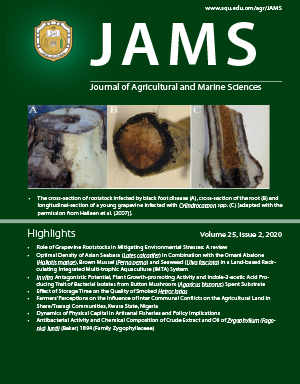Main Article Content
Abstract
Article Details
References
- Al‐Hafedh, Y. S., Alam, A., Buschmann, A. H., 2015. Bioremediation potential, growth and biomass yield of the green seaweed, Ulva lactuca in an integrated marine aquaculture system at the Red Sea coast of Saudi Arabia at different stocking densities and effluent flow rates. Reviews in Aquaculture 7, 161-171.
- Al-Rashdi, K. M., Iwao, T., 2008. Abalone, Haliotis mariae (Wood, 1828), hatchery and seed production trials in Oman. Agri. Mar. Sci. 13, 53-63.
- Ardiansyah, Fotedar, R., 2016. Water quality, growth and stress responses of juvenile barramundi (Lates calcarifer Bloch), reared at four different densities in integrated recirculating aquaculture systems. Aquaculture 458, 113–120
- Cheshuk, B.W., G.J. Purser, G.J., Quintana, R., 2003. Integrated open-water mussel (Mytilus planulatus) and Atlantic salmon (Salmo salar) culture in Tasmania, Australia. Aquaculture 218, 357–378.
- Chopin, T., 2006. Integrated multi-trophic aquaculture. Northern Aquaculture. p. 4.
- Chopin, T., Buschmann, A.H., Halting, C., Troell, M., Kautsky, N., Neori, A., Kraemer, G,P., Zertuche Gonzalez, J.A., Yarish, C., Neefus, C., 2001. Integrating seaweeds into marine aquaculture systems: a key toward sustainability. Journal of Physiology 37, 975-986.
- FAO, 2012. The state of world fisheries and aquaculture 2011. FAO Fisheries and Aquaculture Department, Rome.
- Gaitan, A.G. & Toledo, J.D., 2009. Nursery and grow-out culture of high value fish species in sea cages. In: Training Handbook on Rural Aquaculture, 131-135. Southeast Asian Fisheries Development Center – Aquaculture Department, Tigbauan, Iloilo, Philippines.
- Kungvankij, P., Pudadera, B. J. Jr., Tiro, L. B., Potestas, I. O., 1984. Biology and culture of seabass (Lates calcarifer). NACA Training Manual Series 3, 67 pp.
- Largo, D.B., Diola, A.G., Marababol, M.S., 2016. Development of an integrated multi-trophic aquaculture (IMTA)system for tropical marine species in southern Cebu, Central Philippines. Aquaculture Reports 3, 67–76.
- MacDonald, B. A., Robinson, S. M., Barrington, K. A., 2011. Feeding activity of mussels (Mytilus edulis) held in the field at an integrated multi-trophic aquaculture (IMTA) site (Salmo salar) and exposed to fish food in the laboratory. Aquaculture, 314(1), 244-251.
- Neori, A., Chopin, T., Troell, M., Buschmann, A.H., Kraemer, G.P., Halling, C., 2004. Integrated aquaculture: rationale, evolution and state of the art emphasizing seaweed biofiltration in modern mariculture. Aquaculture 231, 361-391.
- Neori, A., Shpigel, M., Ben-Ezra, D., 2000. A sustainable integrated system for culture of fish, seaweed and abalone. Aquaculture 186, 279-291.
- Troell, M., Hailing, C., Neori, A., Chopin, T., Buschmann, A.H., Kautsky, N., 2003. Integrated mariculture: asking the right questions. Aquaculture 226, 69-90.
References
Al‐Hafedh, Y. S., Alam, A., Buschmann, A. H., 2015. Bioremediation potential, growth and biomass yield of the green seaweed, Ulva lactuca in an integrated marine aquaculture system at the Red Sea coast of Saudi Arabia at different stocking densities and effluent flow rates. Reviews in Aquaculture 7, 161-171.
Al-Rashdi, K. M., Iwao, T., 2008. Abalone, Haliotis mariae (Wood, 1828), hatchery and seed production trials in Oman. Agri. Mar. Sci. 13, 53-63.
Ardiansyah, Fotedar, R., 2016. Water quality, growth and stress responses of juvenile barramundi (Lates calcarifer Bloch), reared at four different densities in integrated recirculating aquaculture systems. Aquaculture 458, 113–120
Cheshuk, B.W., G.J. Purser, G.J., Quintana, R., 2003. Integrated open-water mussel (Mytilus planulatus) and Atlantic salmon (Salmo salar) culture in Tasmania, Australia. Aquaculture 218, 357–378.
Chopin, T., 2006. Integrated multi-trophic aquaculture. Northern Aquaculture. p. 4.
Chopin, T., Buschmann, A.H., Halting, C., Troell, M., Kautsky, N., Neori, A., Kraemer, G,P., Zertuche Gonzalez, J.A., Yarish, C., Neefus, C., 2001. Integrating seaweeds into marine aquaculture systems: a key toward sustainability. Journal of Physiology 37, 975-986.
FAO, 2012. The state of world fisheries and aquaculture 2011. FAO Fisheries and Aquaculture Department, Rome.
Gaitan, A.G. & Toledo, J.D., 2009. Nursery and grow-out culture of high value fish species in sea cages. In: Training Handbook on Rural Aquaculture, 131-135. Southeast Asian Fisheries Development Center – Aquaculture Department, Tigbauan, Iloilo, Philippines.
Kungvankij, P., Pudadera, B. J. Jr., Tiro, L. B., Potestas, I. O., 1984. Biology and culture of seabass (Lates calcarifer). NACA Training Manual Series 3, 67 pp.
Largo, D.B., Diola, A.G., Marababol, M.S., 2016. Development of an integrated multi-trophic aquaculture (IMTA)system for tropical marine species in southern Cebu, Central Philippines. Aquaculture Reports 3, 67–76.
MacDonald, B. A., Robinson, S. M., Barrington, K. A., 2011. Feeding activity of mussels (Mytilus edulis) held in the field at an integrated multi-trophic aquaculture (IMTA) site (Salmo salar) and exposed to fish food in the laboratory. Aquaculture, 314(1), 244-251.
Neori, A., Chopin, T., Troell, M., Buschmann, A.H., Kraemer, G.P., Halling, C., 2004. Integrated aquaculture: rationale, evolution and state of the art emphasizing seaweed biofiltration in modern mariculture. Aquaculture 231, 361-391.
Neori, A., Shpigel, M., Ben-Ezra, D., 2000. A sustainable integrated system for culture of fish, seaweed and abalone. Aquaculture 186, 279-291.
Troell, M., Hailing, C., Neori, A., Chopin, T., Buschmann, A.H., Kautsky, N., 2003. Integrated mariculture: asking the right questions. Aquaculture 226, 69-90.

